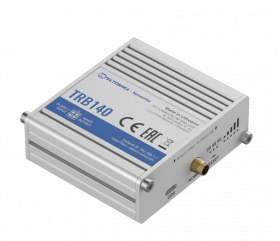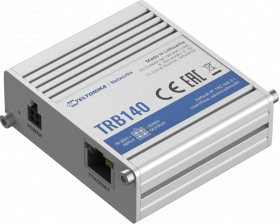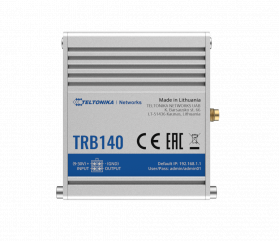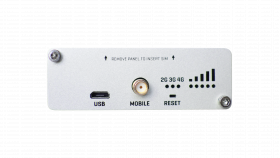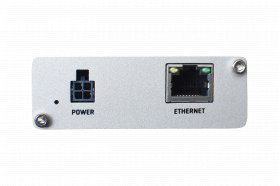Teltonika TRB140 Industrial 4G/LTE Gateway
INDUSTRIAL RUGGED LTE GATEWAY
TRB140 is an ultra-small, lightweight, and energy-efficient IoT device with mission-critical LTE Cat 4 and Gigabit Ethernet connectivity options. Linux environment offers a high degree of customization. This gateway is perfect for projects and applications where a single device must be upgraded with reliable and secure internet connectivity.
Features:
CONNECTIVITY: 4G/LTE (Cat 4), 3G, 2G
COMPACTNESS: Small size, easy installation
PROTOCOLS: Compatible with industrial DNP3 & Modbus communication protocols
RMS: Compatible with Teltonika Networks Remote Management System
Specification:
MOBILE
- Mobile module
4G (LTE) – Cat 4 up to 150 Mbps, 3G – Up to 42 Mbps, 2G – Up to 236.8 kbps
- Status
Signal strength (RSSI), SINR, RSRP, RSRQ, EC/IO, RSCP, Bytes sent/received, connected band, IMSI, ICCID
- SMS
SMS status, SMS configuration, send/read SMS via HTTP POST/GET, EMAIL to SMS, SMS to EMAIL, SMS to HTTP, SMS to SMS, scheduled SMS, SMS autoreply, SMPP
- USSD
Supports sending and reading Unstructured Supplementary Service Data messages
- Black/White list
Operator black/white list
- Multiple PDN
Possibility to use different PDNs for multiple network access and services
- Band management
Band lock, Used band status display
- APN
Auto APN
- Bridge
Direct connection (bridge) between mobile ISP and device on LAN
- Passthrough
Router assigns its mobile WAN IP address to another device on LAN
NETWORK
- Routing
Static routing
- Network protocols
TCP, UDP, IPv4, IPv6, ICMP, NTP, DNS, HTTP, HTTPS, FTP, SMTP, SSL v3, TLS, ARP, VRRP, PPP, PPPoE, UPNP, SSH, DHCP, Telnet, SMPP, SMNP, MQTT, Wake On Lan (WOL)
- VoIP passthrough support
H.323 and SIP-alg protocol NAT helpers, allowing proper routing of VoIP packets
- Connection monitoring
Ping Reboot, Wget Reboot, Periodic Reboot, LCP and ICMP for link inspection
- Firewall
Port forward, traffic rules, custom rules
- DHCP
Static and dynamic IP allocation, DHCP Relay, Relayd
- QoS / Smart Queue Management (SQM)
Traffic priority queuing by source/destination, service, protocol or port, WMM, 802.11e
- DDNS
Supported >25 service providers, others can be configured manually
- Network backup
Mobile, VRRP, Wired options, each of which can be used as an automatic Failover
- Load balancing
Balance Internet traffic over multiple WAN connections
- SSHFS
Possibility to mount remote file system via SSH protocol
SECURITY
- Authentication
Pre-shared key, digital certificates, X.509 certificates
- Firewall
Pre-configured firewall rules can be enabled via WebUI, unlimited firewall configuration via CLI; DMZ; NAT; NAT-T
- Attack prevention
DDOS prevention (SYN flood protection, SSH attack prevention, HTTP/HTTPS attack prevention), port scan prevention (SYN-FIN, SYN-RST, X-mas, NULL flags, FIN scan attacks)
- VLAN
Port and tag based VLAN separation
- Mobile quota control
Custom data limits for SIM card
- WEB filter
Blacklist for blocking out unwanted websites, Whitelist for specifying allowed sites only
- Access control
Flexible access control of TCP, UDP, ICMP packets, MAC address filter
VPN
- OpenVPN
Multiple clients and a server can run simultaneously, 12 encryption methods
- OpenVPN Encryption
DES-CBC, RC2-CBC, DES-EDE-CBC, DES-EDE3-CBC, DESX-CBC, BF-CBC, RC2-40-CBC, CAST5-CBC, RC2-64-CBC, AES-128-CBC, AES-192-CBC, AES-256-CBC
- IPsec
IKEv1, IKEv2, with 5 encryption methods for IPsec (DES, 3DES, AES128, AES192, AES256)
- GRE
GRE tunnel
- PPTP, L2TP
Client/Server instances can run simultaneously, L2TPv3 support
- Stunnel
Proxy designed to add TLS encryption functionality to existing clients and servers without any changes in the program’s code
- DMVPN
Method of building scalable IPsec VPNs
- SSTP
SSTP client instance support
- ZeroTier
ZeroTier VPN client support
- WireGuard
WireGuard VPN client and server support
MODBUS TCP SLAVE
- ID range
Respond to one ID in range [1;255] or any
- Allow Remote Access
Allow access through WAN
- Custom registers
MODBUS TCP custom register block requests, which read/write to a file inside the router, and can be used to extend MODBUS TCP Slave functionality
MODBUS TCP MASTER
- Supported functions
01, 02, 03, 04, 05, 06, 15, 16
- Supported data formats
8 bit: INT, UINT; 16 bit: INT, UINT (MSB or LSB first); 32 bit: float, INT, UINT (ABCD (big-endian), DCBA (little-endian), CDAB, BADC)
MODBUS DATA TO SERVER
- Protocol
HTTP(S), MQTT, Azure MQTT
MQTT GATEWAY
- MQTT Gateway
Allows sending commands and receiving data from MODBUS Master through MQTT broker
DNP3
- Supported modes
TCP Master, DNP3 Outstation
MONITORING & MANAGEMENT
- WEB UI
HTTP/HTTPS, status, configuration, FW update, CLI, troubleshoot, event log, system log, kernel log
- FOTA
Firmware update from server, automatic notification
- SSH
SSH (v1, v2)
- SMS
SMS status, SMS configuration, send/read SMS via HTTP POST/GET
- Call
Reboot, Status, Mobile data on/off, Output on/off, answer/hang-up with a timer
- TR-069
OpenACS, EasyCwmp, ACSLite, tGem, LibreACS, GenieACS, FreeACS, LibCWMP, Friendly tech, AVSystem
- MQTT
MQTT Broker, MQTT publisher
- SNMP
SNMP (v1, v2, v3), SNMP Trap
- JSON-RPC
Management API over HTTP/HTTPS
- MODBUS
MODBUS TCP status/control
- RMS
Teltonika Remote Management System (RMS)
IOT PLATFORMS
- Cloud of Things
Allows monitoring of: Device data, Mobile data, Network info, Availability
- ThingWorx
Allows monitoring of: WAN Type, WAN IP, Mobile Operator Name, Mobile Signal Strength, Mobile Network Type
- Cumulocity
Allows monitoring of: Device Model, Revision and Serial Number, WAN Type and IP, Mobile Cell ID, ICCID, IMEI, Connection Type, Operator, Signal Strength
- Azure IoT Hub
Can send device IP, Number of bytes send/received, Temperature, PIN count to Azure IoT Hub server, Mobile connection state, Network link state, IMEI, ICCID, Model, Manufacturer, Serial, Revision, IMSI, SIM State, PIN state, GSM signal, WCDMA RSCP, WCDMA EC/IO, LTE RSRP, LTE SINR, LTE RSRQ, CELL ID, Operator, Operator number, Connection type
SYSTEM CHARACTERISTICS
- CPU
ARM Cortex-A7 1.2 GHz
- RAM
128 MB, DDR2
- FLASH storage
512 MB, SPI Flash
FIRMWARE / CONFIGURATION
- WEB UI
Update FW from file, check FW on server, configuration profiles, configuration backup
- FOTA
Update FW
- RMS
Update FW/configuration for multiple devices at once
- Keep settings
Update FW without losing current configuration
FIRMWARE CUSTOMIZATION
- Operating system
RutOS (OpenWrt based Linux OS)
- Supported languages
Busybox shell, Lua, C, C++
- Development tools
SDK package with build environment provided
INPUT / OUTPUT
- Input
1 x Digital Input, 0 - 6 V detected as logic low, 8 - 30 V detected as logic high
- Output
1 x Digital Output, Open collector output, max output 30 V, 300 mA
- Events
Email, RMS, SMS
- I/O juggler
Allows to set certain I/O conditions to initiate event
POWER
- Connector
4-pin industrial DC power socket
- Input voltage range
9 – 30 VDC, reverse polarity protection; surge protection >31 VDC 10us max
- PoE (passive)
Passive PoE over spare pairs. Possibility to power up through LAN port, not compatible with IEEE802.3af, 802.3at and 802.3bt standards, Mode B, LAN1 Port, 9 - 50 VDC
- Power consumption
< 5 W
PHYSICAL INTERFACES
- Ethernet
1 x RJ45 port, 10/100/1000 Mbps
- I/O’s
1 x Digital Input, 1 x Digital Output on 4-pin power connector
- Status LEDs
3 x connection type status LEDs, 5 x connection strength LEDs, 2 x LAN status LEDs, 1x Power LED
- SIM
1 x SIM slot (Mini SIM – 2FF), 1.8 V/3 V
- Power
1 x 4-pin power connector
- Antennas
1 x SMA for LTE
- USB
1 x Virtual network interface via micro USB
- Reset
Reboot/User default reset/Factory reset button
PHYSICAL SPECIFICATION
- Casing material
Aluminum housing
- Dimensions (W x H x D)
74.5 x 25 x 64.4 mm
- Weight
134 g
- Mounting options
Bottom and sideways DIN rail, Flat surface
OPERATING ENVIRONMENT
- Operating temperature
-40 °C to 75 °C
- Operating humidity
10% to 90% non-condensing
- Ingress Protection Rating
IP30
REGULATORY & TYPE APPROVALS
- Regulatory
CE/RED, EAC, RoHS, WEEE
EMI IMMUNITY
- Standards
Draft EN 301 489-1 V2.2.0, Draft EN 301 489-17 V3.2.0, Draft EN 301 489-19 V2.1.0, Draft EN 301 489-52 V1.1.0
FCC 47 CFR Part 15B (2017), ANSI C63.4 (2014)
- ESD
EN 61000-4-2:2009
- RS
EN 61000-4-3:2006 + A1:2008 + A2:2010
- EFT
EN 61000-4-4:2012
- Surge protection
EN 61000-4-5:2014
- CS
EN 61000-4-6:2014
- DIP
EN 61000-4-11:2004
RF
- Standards
EN 300 511 V12.5.1, ETSI EN 301 908-1 V11.1.1, ETSI EN 301 908-1 V11.1.2, EN 301 908-2 V11.1.2, ETSI EN 301 908-13 V11.1.2
SAFETY
- Standards
IEC 62368-1:2014(Second Edition), EN 62368-1:2014+A11:2017
EN 50385:2017
EN 62232:2017

